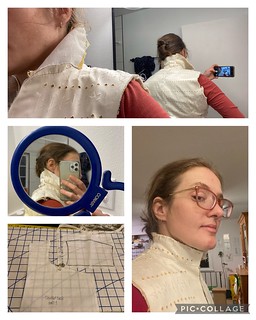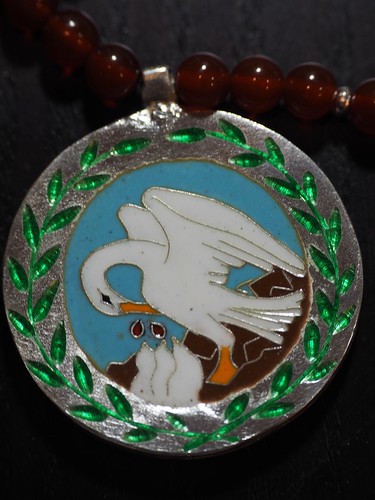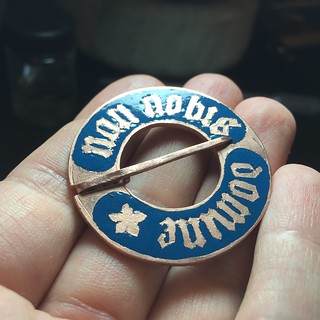Two years ago I said: "I'm learning a lot about late period tailoring, construction and finishing. But there have definitely been some wrinkles. So, I guess, go in with some caution, and if something doesn't seem right to your purposes, you don't have to just trust it."
So yeah! The straight front women's doublet in MMv2 has a collar drafted to height L-o. Maybe that's just perfect for the style you're going for - tall, rolled over, probably worn open. If you want a straight, closed collar that fits under your chin, you can bring that whole thing down to L-d. (and still use one dedo for tapering the front). Really. Photo collage shows before and after.
Anyway, if you want to see actual content from me, you'll have more luck over at @catrijnmakes on Instagram.
06 December 2022
31 January 2021
Please do not mind the zombie post
So, what could get me to write a new post for a dead blog? Did you guess irritation/frustration?
I'm very slowly working on a project to extend my wardrobe into the end of SCA period, around 1580-1600. I'm primarily using M. Gnagy's Modern Maker series (books and videos) for patterning and construction, with portrait references for stylistic details. The kirtle continues to be a major workhorse of a woman's outfit, so that's where I started. It's my first time using the Bara system.
If you're not familiar, the Bara system, used in the late Spanish tailors' books, is a proportional drafting system. The units of measure are subdivided fractions of body measurements like chest, waist, and height. Starting with a tape or string of the correct total measure, it is marked down in half, thirds, quarters, sixths, eighths, and even smaller divisions. It essentially shifts the math to a different point in the process. If I need to mark 1/4 of a chest measurement of 38in or 96cm, in a modern system, I'd do the division, grab a single tape measure in standard units, and mark at 9.5in or 24cm. In the Bara system, I pick up the measure labeled 38in, and mark at the line marked 1/4 (Q). It's an interesting way of thinking. I like that this makes the old pattern manuals more interpretable and accessible. That said, I've made more mistakes using this system than I ever have in any other kind of drafting. Two tips from my mistakes. First, a tape that has any stretch or give is NOT your friend. Cotton twill tape? Right out. Try for tabby woven, and artificial fibers are probably better. Who'd think I'd ever say that. Second, get yourself some alphabet charms, put them on safety pins, and attach them to the tapes in use. I'm not even kidding. I've made so many errors just by grabbing the wrong one.
The other thing to comment on is the drafts themselves. I don't know how much of the problem comes from each of various sources - no draft is truly universal, using Spanish patterns for a Dutch style, or inherent issues. My kirtle skirt I ended up doing completely twice (and actually cutting a third time) because the result of the draft was not what I wanted or expected. If you're using the pattern in v.2 p.162-163 and want the look of p.175 or 177, increase the waist measurents significantly (I believe I ended at W-QQQ for both front and back), and you may need to increase the bottom width to keep proportion, perhaps L-BM. The second part is to closely observe the length between side and center. Each side is drafted to L-BM, and so is the center... until you drop the waist curve. Now the front and back length is significantly shorter. Maybe this is just right for wearing over the bum pad? But for my look, it just gave me an uneven hem that was an absolute pain to fix. If doing it again, I'd lengthen the bottom as well when drawing in the waist curve. For my still in the drafting stage doublet, the initial draft fit pretty well, except having a very high waist cut around sides and back. I'm lengthening by 1.5-2" to hit the waist line of my kirtle, which is still slightly above my natural waist. I'm not tall, I'm petite; I don't think of myself as having an unusually long torso.
I don't want it to come across like I'm bashing the Modern Maker. I'm learning a lot about late period tailoring, construction and finishing. But there have definitely been some wrinkles. So, I guess, go in with some caution, and if something doesn't seem right to your purposes, you don't have to just trust it. I'm not entirely happy with this kirtle, but I'm just so DONE with it and I'm moving on.
I'm very slowly working on a project to extend my wardrobe into the end of SCA period, around 1580-1600. I'm primarily using M. Gnagy's Modern Maker series (books and videos) for patterning and construction, with portrait references for stylistic details. The kirtle continues to be a major workhorse of a woman's outfit, so that's where I started. It's my first time using the Bara system.
If you're not familiar, the Bara system, used in the late Spanish tailors' books, is a proportional drafting system. The units of measure are subdivided fractions of body measurements like chest, waist, and height. Starting with a tape or string of the correct total measure, it is marked down in half, thirds, quarters, sixths, eighths, and even smaller divisions. It essentially shifts the math to a different point in the process. If I need to mark 1/4 of a chest measurement of 38in or 96cm, in a modern system, I'd do the division, grab a single tape measure in standard units, and mark at 9.5in or 24cm. In the Bara system, I pick up the measure labeled 38in, and mark at the line marked 1/4 (Q). It's an interesting way of thinking. I like that this makes the old pattern manuals more interpretable and accessible. That said, I've made more mistakes using this system than I ever have in any other kind of drafting. Two tips from my mistakes. First, a tape that has any stretch or give is NOT your friend. Cotton twill tape? Right out. Try for tabby woven, and artificial fibers are probably better. Who'd think I'd ever say that. Second, get yourself some alphabet charms, put them on safety pins, and attach them to the tapes in use. I'm not even kidding. I've made so many errors just by grabbing the wrong one.
The other thing to comment on is the drafts themselves. I don't know how much of the problem comes from each of various sources - no draft is truly universal, using Spanish patterns for a Dutch style, or inherent issues. My kirtle skirt I ended up doing completely twice (and actually cutting a third time) because the result of the draft was not what I wanted or expected. If you're using the pattern in v.2 p.162-163 and want the look of p.175 or 177, increase the waist measurents significantly (I believe I ended at W-QQQ for both front and back), and you may need to increase the bottom width to keep proportion, perhaps L-BM. The second part is to closely observe the length between side and center. Each side is drafted to L-BM, and so is the center... until you drop the waist curve. Now the front and back length is significantly shorter. Maybe this is just right for wearing over the bum pad? But for my look, it just gave me an uneven hem that was an absolute pain to fix. If doing it again, I'd lengthen the bottom as well when drawing in the waist curve. For my still in the drafting stage doublet, the initial draft fit pretty well, except having a very high waist cut around sides and back. I'm lengthening by 1.5-2" to hit the waist line of my kirtle, which is still slightly above my natural waist. I'm not tall, I'm petite; I don't think of myself as having an unusually long torso.
I don't want it to come across like I'm bashing the Modern Maker. I'm learning a lot about late period tailoring, construction and finishing. But there have definitely been some wrinkles. So, I guess, go in with some caution, and if something doesn't seem right to your purposes, you don't have to just trust it. I'm not entirely happy with this kirtle, but I'm just so DONE with it and I'm moving on.
10 August 2017
Secret Project: Intarsia Pillows
This was one of 2016-2017's secret projects - a pair of pillows in sewn intarsia.
This was initially conceived as a no-occasion gift for a dear friend, whose heraldry includes a red mermaid on a white background. The original design featured only the mermaid. However, when she was announced for the SCA's Order of the Pelican, it was a little too perfect. The mermaids had already been cut, and one sewn back together, but there was enough space to add the border of blood drops, and this gave me a firm deadline!
Intarsia, as pertains to sewing/embroidery, not knitting, is sort of like an un-backed applique. Instead of putting a design on a ground fabric, two identical designs are cut and exchanged, and then carefully stitched back into a solid piece with a whip stitch joining raw edges that are just butted together. The examples I know of are late medieval and Scandinavian, I'm not sure if it was more widely used than that - when I first saw them in Stockholm, I'd never heard of this before, and there don't seem to be many resources on it in English. Extant pieces seem to be home and church textiles, such as bedcoverings and cushions. The fabrics I used were red and cream/white wool flannels, I believe from Wm. Booth Draper, sewn with linen thread. The couched edging and details are ~2-2.5mm strips of "gold" goatskin leather, surprisingly cheap from Tandy's outlet store. The wool was all joined before I started the couching, so there are two layers of stitching everywhere that the leather is over a join. The backs of the pillows are in the opposite color wool, and it all encloses a feather pillow.
This was definitely a learning project; I jumped in hoping to figure it out as I went along. Although I did simplify the mermaid design, I could have gone further with that. Points and sharp corners really don't work well here! Sewing around raw edges is tricky, too close or too tight and you can pull the weave apart. In general, tighter weaves would be better. Finally, for drawing in my detail lines, I used my soapstone marker on the red (brushed off fine) and pink chalk on the white, which remained way too visible! In the end, I had to wash the whole panel. Yes, that's right, I stuck non-prewashed red and white wools, plus leather, in a sink full of water hoping to get pink spots out (not add more)! Everything turned out fine, but it was nerve-wracking.
This was initially conceived as a no-occasion gift for a dear friend, whose heraldry includes a red mermaid on a white background. The original design featured only the mermaid. However, when she was announced for the SCA's Order of the Pelican, it was a little too perfect. The mermaids had already been cut, and one sewn back together, but there was enough space to add the border of blood drops, and this gave me a firm deadline!
Intarsia, as pertains to sewing/embroidery, not knitting, is sort of like an un-backed applique. Instead of putting a design on a ground fabric, two identical designs are cut and exchanged, and then carefully stitched back into a solid piece with a whip stitch joining raw edges that are just butted together. The examples I know of are late medieval and Scandinavian, I'm not sure if it was more widely used than that - when I first saw them in Stockholm, I'd never heard of this before, and there don't seem to be many resources on it in English. Extant pieces seem to be home and church textiles, such as bedcoverings and cushions. The fabrics I used were red and cream/white wool flannels, I believe from Wm. Booth Draper, sewn with linen thread. The couched edging and details are ~2-2.5mm strips of "gold" goatskin leather, surprisingly cheap from Tandy's outlet store. The wool was all joined before I started the couching, so there are two layers of stitching everywhere that the leather is over a join. The backs of the pillows are in the opposite color wool, and it all encloses a feather pillow.
This was definitely a learning project; I jumped in hoping to figure it out as I went along. Although I did simplify the mermaid design, I could have gone further with that. Points and sharp corners really don't work well here! Sewing around raw edges is tricky, too close or too tight and you can pull the weave apart. In general, tighter weaves would be better. Finally, for drawing in my detail lines, I used my soapstone marker on the red (brushed off fine) and pink chalk on the white, which remained way too visible! In the end, I had to wash the whole panel. Yes, that's right, I stuck non-prewashed red and white wools, plus leather, in a sink full of water hoping to get pink spots out (not add more)! Everything turned out fine, but it was nerve-wracking.
10 July 2017
A little something to tie you over
The secret projects are done! I even have pictures of some of them, I just need to get organized and find some time to write posts. This is a medallion I did for a dear friend - fine silver with cloisonne enamel. The outer wreath is engraved and filled, so it might be considered champleve.
24 March 2017
Burgundian gown pattern layout
I've been meaning to blog this forever: how I cut my Burgundian gowns. And since I was cutting a new one, I finally have a picture of my layout. Obviously, there's some distortion from creating the panoramic, but you can get the idea. My back panels are cut like a 4-panel supportive kirtle, with flared skirt. Laying them on the selvage leaves a large wedge between them that becomes the center back gore. The front panels are cut differently, with the selvage going all the way up the neckline to the shoulder. Like the back, the skirt is flared as much as fabric width allows. The leftover bit between the fronts is enough for sleeves, cuffs, and collar. How this works in practice, and why there's only one gore is this: the angling of the front pulls the fullness forward, draping in folds at center front with the side seams pulled forward from the normal vertical line. The big gore in the back then replaces all the fullness that the front is stealing, making it even. I think it works really well, and it's a fairly efficient layout.
I have several other projects I'm working on, including some exciting things, but they are !sssh~secret!, with a few months to go before unveiling.
I have several other projects I'm working on, including some exciting things, but they are !sssh~secret!, with a few months to go before unveiling.
17 January 2017
What was I doing in 2016?
As I alluded to earlier, there were some projects in 2016, despite the lack of blogging!
Sewing: aside from the brick stitch pouch, I made myself some basic, everyday wear. I made two more pirihan for my Persian wear - shirts were by far the limiting factor on how many days I could wear this style. I expanded my male clothing - a short tunic, two pairs of braies, and cheater hose. The braies and hose have elastic waistbands, and the hose just have stirrups instead of full feet. But they're comfortable and very practical. Finally, for my elevation I made a handsewn wool tunic for the vigil, and a white wrap dress to wear over my other clothes on my way into court.
I've been continuing to expand my metal an enamel work. The annular pin here was started in 2015, but in 2016 I finished the engraving, applied the enamel, and did the finishing work. I have a stupid-large cloisonne medallion in progress. Finally, I engraved a plate for intaglio printing; these were my vigil tokens.
Sewing: aside from the brick stitch pouch, I made myself some basic, everyday wear. I made two more pirihan for my Persian wear - shirts were by far the limiting factor on how many days I could wear this style. I expanded my male clothing - a short tunic, two pairs of braies, and cheater hose. The braies and hose have elastic waistbands, and the hose just have stirrups instead of full feet. But they're comfortable and very practical. Finally, for my elevation I made a handsewn wool tunic for the vigil, and a white wrap dress to wear over my other clothes on my way into court.
I've been continuing to expand my metal an enamel work. The annular pin here was started in 2015, but in 2016 I finished the engraving, applied the enamel, and did the finishing work. I have a stupid-large cloisonne medallion in progress. Finally, I engraved a plate for intaglio printing; these were my vigil tokens.
Subscribe to:
Posts (Atom)





